#dampstains
Explore tagged Tumblr posts
Text
A volume from Hamilton's library, possibly signed by two of his sons
Hamilton had a large library and interest in several different types of books. His fascinating collection was said to have contained books in French, and different genres like philosophy, law, trading, and politics. Unfortunately, through inheritance and time the collection has been divided between several people and families most of it is lost to this day. But a particular interesting find is one of Hamilton's old books, Lex mercatoria rediviva; or, A Complete Code of Commercial Law: Being a General Guide to All Men in Business, by Wyndham Beawes.

With an account of our mercantile companies, our colonies and factories abroad, our commercial treaties with foreign powers, the duty of consuls, and of the laws concerning aliens, naturalization and denization: to which is added, a sketch of the present state of the commerce of the whole world, describing the manufactures and products of each particular nation, with tables of correspondence, and agreement of their respective coins, weights and measures.
The books is Volume 1, (241 x 152 mm), and is also the sixth edition. It lacks all preliminaries before advertisement leaf (including title-page), and all after S1 at end, there is dampstaining and light browning throughout it. Contemporary calf, smooth spine, morocco label, blind-stamped letter “H” for “Hamilton” to center; worn with losses to spine and corners, spine and text-block split down the center, hinges reinforced with cloth tape. Half blue morocco slipcase, chemise.
It's no surprise as to why such a book would be found in Hamilton's collection, commerce was rooted throughout Hamilton's childhood. At the young age of eight, in 1765, Hamilton would be a clerk for his mother's shop in Christiansted, St. Croix. After his mother's death in 1768, Hamilton soon found work in Christansted at the trade firm of Beekman and Cruger, who were both New York merchants. In an exceeding pace, he rose from clerk to manager, keeping the firm's books, dealing with ship captains, planters, merchants, Customers and suppliers, and buying and selling profitably on behalf of his employers. It was perhaps at Beekman and Cruger's that Hamilton first found Beawes's book on British commercial law.
In any case, Hamilton had definitely found the book in his hand during his college days at King's college. The book is quoted in his well-known pamphlet Farmer Refuted, in 1775;
“I shall sum up my whole remarks (says another writer) on our American colonies, with this observation, that, as they are a certain annual revenue of several millions sterling to their mother country, they ought carefully to be protected, duly encouraged, and every opportunity, that presents, improved for their increment and advantage; as every one, they can possibly reap, must at last return to us, with interest.”
Source — The Farmer Refuted, [February 23, 1775]
And later on in 1781, Hamilton asked Pickering for a copy of Lex mercatoria which he needed in order to compose an important letter to Robert Morris regarding the restoration of the colonies' credit and credibility in the eyes of foreign nations;
Let me know the result of your examination whether you can appoint a barrak Master to the French army; if you can, the General wishes you to appoint Col Champlin without delay. Have you the tract written by Price in which he estimates the specie & current cash of Great Britain? Have you Humes Essay’s, Lex Mercatoria or Postlethwait? Any of these books you may have, you will singularly oblige me by the loan of them. Be so good as to forward the inclosed by the first opportunity.
Source — Alexander Hamilton to Timothy Pickering, [April 20, 1781]
Later on Hamilton must have purchased another edition, as this particular copy was sold by H. and P. Rice, No. 50, Market-Street, Philadelphia, in 1795. And then signed his name in the Content's passage;
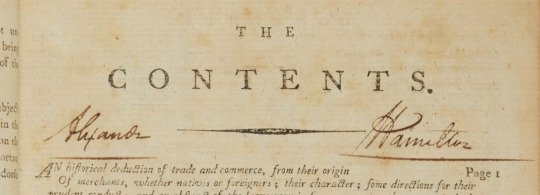
What is most interesting about this book though is the two signatures on the back possibly signed by Hamilton's eldest and youngest sons, Philip Hamilton, and “Little Phil”.
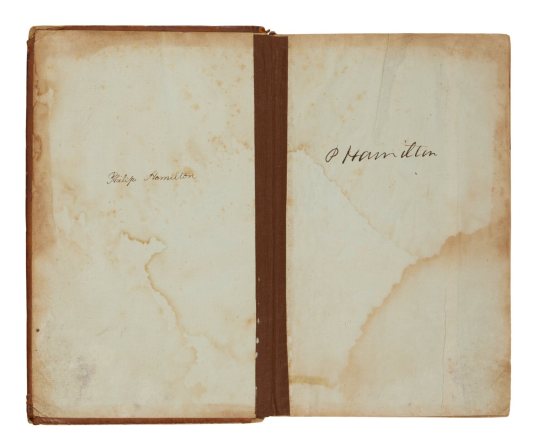
Philip seems to have taken a considerable interest in literature and there are many mentions of him lending or reading books. Philip graduated from his father's alma mater, King's College, in 1800 and immediately embarked upon a regimental reading of the law laid out by Hamilton. The books contains subjects and insight of law, which is likely why Hamilton might have passed it down to his son. But in 1802, challenged to a duel after an argument and scuffle that involved disparaging remarks about his father's political party, Philip was fatally wounded at Paulus Hook. Later that year, Eliza gave birth to their youngest son, who was named after his deceased brother. And might have taken up his volume of Lex mercatoria as well.
There have been more of Hamilton's old books found with his children's signatures inside of them. Another case being a book located in Columbia College (Formerly known as King's college) with Philip's and Hamilton's fourth son's signature, James Alexander Hamilton's. Although it has been argued that these “Philip signatures” could be Hamilton's great-grandchildren's, rather than his children's. As James did have a grandson named Philip and could have given the book to him instead of it originally belonging to his eldest brother;
In addition, it is interesting to note that Alexander Hamilton's son James—who was born and lived in New York, later returning and becoming an attorney like his father—was married to a daughter (Mary) of Robert Morris, whose inscription appears opposite the title page of a book of a different kind owned and autographed by Alexander Hamilton. Morris comments there that this book was given to him by Alexander in place of one that Morris had loaned to Alexander, who mislaid it. But the book in question is not in itself of direct interest here.
Although certain other books bearing Alexander Hamilton's signature of ownership are not of direct interest here, one of them is also autographed by Philip Hamilton. Philip was the name of Alexander Hamilton's oldest son (killed in an 1801 duel) as well as the name of the grandson of Alexander's third son, James, cited above. Since Alexander's son Philip (b. 1782) was nearly 20 when killed prior to his father's death, it is likely that he, like his younger brother James, inscribed his name in such books, even before their father's death in 1804, that is, in books that Alexander possessed and gave to his sons and that like others remained in Alexander's family orbit for him to see. Or, the book in question could have been acquired by Alexander's son James and later handed down to James' grandson Philip, although in that case one might have expected James to be an autographer as well, which he was not.
Source — Origins of Legislative Sovereignty and the Legislative State, Volume 6, by A. London Fell
Which could be an argument here, but there is no indication this particular book was passed down to anymore children after Phil signed his name.
When comparing the similarities of the signatures with the signatures seen from the brothers in their letters, it is safe to assume the signature on the left page is Phil II's, and the one on the right is Philip's. As Philip seems to have often merely left his first name signed off as nothing but a “P”, usually taking on an “O” shape. While Phil seems to have preferred writing out his full name.
Little Phil's signatures;

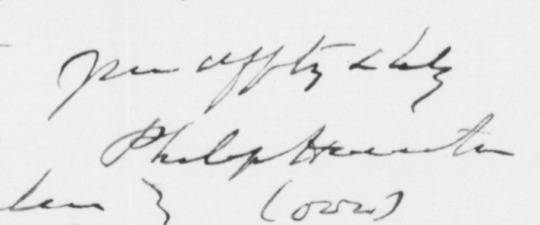
Philip's signatures;

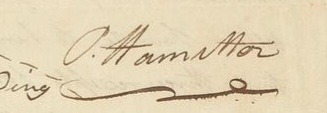
Although it is debatable, as Sotheby's disagrees and claims Philip's signature is on the front free endpaper—while Phil's signature is on the front pastedown.
Source: Sotheby's.
#amrev#american history#alexander hamilton#historical alexander hamilton#philip hamilton#philip hamilton ii#history#historical artifacts#hamilchildren#hamilton family#hamilton children#hamilkids#hamilton kids#cicero's history lessons
21 notes
·
View notes
Photo

DIGGES, LEONARD. C.1515-1559.
A geometrical practical treatize named Pantometria, divided into three bookes....
London: Abell Jeffes, 1591.Small folio (268 x 178 mm). Engraved vignette on title page, 2 large woodcut coats-of-arms, numerous woodcut initials, illustrations, head- and tail-pieces in text, errata leaf at end. Modern quarter calf antique and marbled boards, edges gilt, large bookplate and blue morocco blind-stamped coats-of-arms cut from earlier binding and laid down to front endpapers. Marginal paper repairs to some edges and corners, lacking initial blank, dampstaining from leaf D1 to end, old ink ownership inscriptions to title, ink marginalia, minor soiling and staining.
Provenance: : Sir William Stirling-Maxwell [1818-1878] (bookplate).
Second edition, but considered superior to the first, as it was greatly expanded by the author's son, Thomas Digges (c.1546-1595). This work on practical applied geometry contains the first description of the theodolite, one of Leonard Digges's inventions, and the earliest description of what we would come to call the telescope. In this addition, Leonard Digges has added sections on navigation, ballistics, and pyrotechnics. Cockle 16; ESTC S107357; Tomash & Williams D54.
(via Bonhams)
3 notes
·
View notes
Photo

CAZABON, Michel Jean (1813-1888) and CICÉRI, Eugène (1813-1890). Views of Trinidad. Paris: Lemercier, 1851.
CAZABON, Michel Jean (1813-1888) and CICÉRI, Eugène (1813-1890). Views of Trinidad. Paris: Lemercier, 1851. The first edition of “possibly the finest set of engravings that has ever been produced of the West Indes” (Maclean). Born in Trinidad, Cazabon studied in Europe before setting up his studio in Port of Spain in 1848. “Quick to see the need for pictures of Trinidad to illustrate its landscape and architecture to the families and friends of English and French settlers, [Cazabon] ... decided to publish a folio of lithographs and invited subscriptions.” The present album was published in 1851, with lithographs by Eugène Cicéri after Cazabon’s drawings. 149 copies were subscribed. Abbey Travel II, 696; MacLean, Cazabon: an Illustrated Biography, 1986. Oblong folio (287 x 402mm). Lithographic title, 18 tinted lithographs interleaved with tissue guards, list of subscribers (spotting, occasionally affecting plates; faint dampstain to final leaves). Contemporary cloth-backed marbled boards (light wear to edges, spine chipped).
source
12 notes
·
View notes
Photo










I just listed for sale this incredible book from 1633. I’m awed just looking at it.
AVAILABLE ON eBAY
Masoret HaBrit Exercitationes Biblicae de Hebraei Graecique Textus
Ioanne Morino (Jean Morin)
LATIN & HEBREW LANGUAGE BOUND IN VELLUM FIRST EDITION RARE
This book is of a work of biblical criticism in which Morin maintained that the text of Septuagint was more reliable than that of the Hebrew Bible. A revised version in 2 parts was published posthumously in 1660.
Publisher: Antonius Vitray, Paris Copyright: 1633
CONDITION: This book is in very good condition for its age. Vellum. Vellum boards have worm damage along top and bottom of spine and along the top edge of front cover. Beautiful hand-tooled gilt detail on spine. Hinges tight. Binding sturdy. The text block is toned with occasional foxing. A beautiful example of typography, this book is written in both Hebrew and Latin and uses many original drop-caps and fleurons. There is a dampstain in upper outer corner of opening leaves. The title page bears the library stamps of Francisco Plancarte y Navarrete (1856-1920), Bishop of Campeche and Bishop of Cuernavaca.
457 pages, includes extensive index 6.75" x 9.125" (4to, 228x169 mm)
#vellum#ancient books#1600s#books from the 1600s#antiquarian books#antiquarian#religious books#latin texts#hebrew texts#bible criticism#old books#amazing finds#amazing books#bookish#books and literature#books and libraries#scholarly books#religious texts#first editions#leather books#books#booklover#booklife#bookseller#jean morin#Ioanne Morino#Exercitationes Biblicae#religious criticism
11 notes
·
View notes
Photo
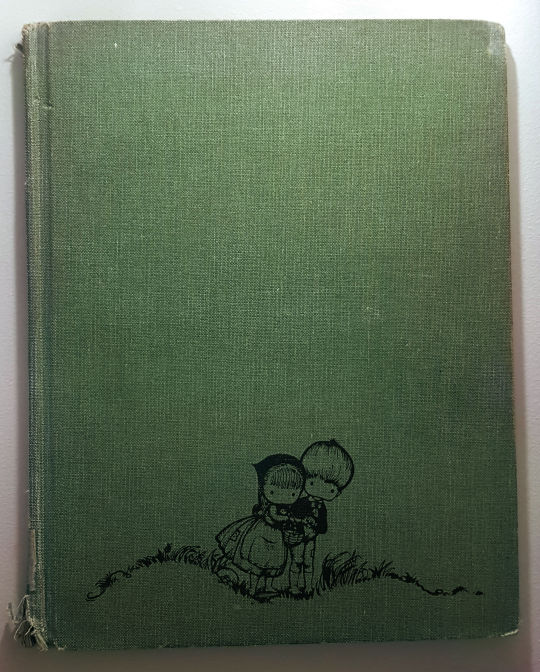
Nibble Nibble Mousekin by Joan Walsh Anglund / The Brothers Grimm
Unpaginated [29 p.] ; illustrated. Ex-library with only one unobtrusive number stamp to title page. Pictorial green cloth hardcover is worn, with mild dampstains, significant edgewear, and some damage to tip and heel of spine. Minor stains and nicks to th... more
Offered By The Mortuary Library
#Joan Walsh Anglund / The Brothers Grimm#Children's Books#Nibble Nibble Mousekin#Folklore#Supernatural#Fantasy#Adventure#Magic & Witchcraft#biblio#biblio.com#Hansel and Gretel#German Fairytale#Fiction#Children's Story#Picture Book#Illustrated Fairy Tale#Classic#Cannibalism#Hunger#Poverty#1960s#Vintage#independent booksellers#books for sale#used books#cover art#vintage books#creepy children's books
1 note
·
View note
Text
I’ve decided to list them chronologically,
[not by size or language or (God forgive me, Importance) or Price, or where they are on my shelf….while slightly arbitrary, it has some sense to it, I hope.]
Please enjoy.
James
1)- 355J Bible Saint Jerome, Biblia cum summariis concordantiis 1500
2) The (Catholic) New Testament Rhemes 1582
3) The 1611 King James ‘HE’ bible
4) 1774 Pocket King James Bible .
355J Bible Saint Jerome, Biblia cum summariis concordantiis 1500
The 1611 King James ‘HE’bible

1774 King James Bible .
#1 355J Bible Saint Jerome, Gabriello Bruno (active 1480-1514.);
Biblia cum summariis concordantiis : diuisionibus: quattuor repertoriis p[ro]positis: numeriq[ue] foliorum distinctione: terse et fidelit[er] imp[re]ssa.
[Lyons]: Jean Pivard, 29 Jan. 1500 & 1. $ 11,500.

Folio 10 1/2 x 7 3/4 inches inches, &8 ç8 , a8 [a1 blank and present] b6, c-z8 A-Z8 Aa8 Bb8; aa-cc8 dd10 [dd10 blank and lacking] . Bound in original full calf over wooden boards with 10 brass bosses. with many scribbled out ownership markings (frustratingly unidentified)
This Bible also includes the “Tabula alphabetica” of Gabriel Bruno, and notes on “translatores … Biblie”, and “modi intelligendi … scripturam”; at the end, “Interpretationes nominum hebraycorum”; with marginal references.
&1r [Title-page.] &1v [Pivard, Jean: Introductory letter addressed to the reader.] Incipit: ‘Ne nesciens et ob id ingratus sacrosanctam diuini verbi . . .’&1v ‘Pulchra et vtilis diuisio totius Biblie’. &1v ‘In tabulam primam de ordine librorum ad lectorem disticon’. Incipit: ‘Perspice nunc, lector, quis debitus ordo librorum’; 1 distich.
&1v ‘Prima quattuor tabulorum’. &2v ‘Tabula secunda continens libros Biblie per ordinem alphabeti’. &2v [Alexander de Villa Dei pseudo-]: ‘Tertia tabula’. Pref. no. 58. ,[con]1r Brunus, Gabriel: ‘Quarta tabula’.
ç 8r [Explanatory note about translators of the Bible and commentators.]
ç 8v ‘Modi intelligendi sacram scripturam’. a2r Hieronymus: [Letter addressed to] Paulinus [ep. 53]. ‘Prologus in Bibliam’.. On this edition see also Hillard, ‘Les éditions de la Bible’, 72-3.
Goff B604; ISTC: ib00604000; GW 4281; Pell (Lyon) 137; Copinger, Incunabula Biblica, 120; Darlow–Moule 6090; HC 3128; Proctor: 8670;Sheppard 6736; Pell; 2341.
FIVE US COPIES
1)Boston Public Library, 2)General Theological Seminary, 3) Jewish Theological Seminary of America, 4)Library of Congress, Rare Book Division, 5) Southern Methodist Univ., Bridwell Library (418 ff)
*§*
*§* *§*
The First English Catholic New Testament in English, printed at the seminarie at Rhemes
#2. 226J The Nevv Testament.
The Nevv Testament of Iesus Christ, translated faithfully into English, out of the authentical Latin, according to the best corrected copies of the same, diligently conferred vvith the Greeke and other editions in diuers languages; vvith arguments of bookes and chapters, annotations, and other necessarie helpes, for the better vnderstanding of the text, and specially for the discouerie of the corruptions of diuers late translations, and for cleering the controversies in religion, of these daies: in the English College of Rhemes.
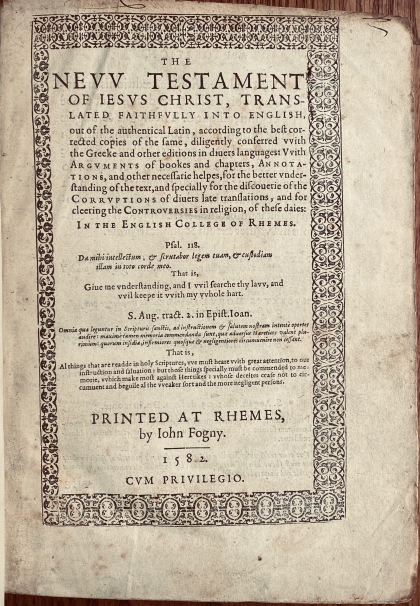
Printed at Rhemes : By Iohn Fogny, 1582. $45,000
Quarto 218 x 165 mm a-c4, d2, A-Z4, Aa-Zz4, Aaa-Zzz4, Aaaa-Zzzz4, Aaaaa-Ddddd4, Eeeeee2. The First English Catholic New Testament in English This copy is bound in seventeenth-century calf, sympathetically rebacked, with an attractive gold-tooled floral motif to the board edges. Internally, this copy is in very good condition with clean leaves. There is a little foxing to the first two leaves and a few trivial marginal tears. The upper margin is cut a bit close but the text is never affected.
The title page is set within a decorative border; the text is adorned with ornamental woodcut initials throughout. The text is beautifully printed in Roman with printed annotations, marginal notes, arguments and chapter summaries in italic. “The ‘editio princeps’ of the Roman Catholic version of the New Testament in English. Translated from the Vulgate by Gregory Martin, under the supervision of William Allen and Richard Bristow. According to the “Douai Diaries”, Martin began the translation in October1578 and completed it in March 1582.
“The translation adheres very closely to the Latin, though it shows traces of careful comparison with the Greek. But its groundwork was practically supplied by the existing English versions, from which Martin did not hesitate t borrow freely. In particular there are very many striking resemblances between Martin’s renderings and those in Coverdale’s diglot of 1538. Martin’s own style is often disfigured by Latinisms.
“This Rheims New Testament exerted a very considerable influence on the King James version of 1611, transmitting to it not only an extensive vocabulary, but also numerous distinctive phrases and turns of expression. (See J.G. Carleton’s exhaustive analysis, The Part of Rheims in the Making of the English Bible. Oxford: Clarendon Press, 1902.)
“Since the English Protestants used their vernacular translations not only as the

foundation of their own faith but as siege artillery in the assault on Rome, a Catholic translation became more and more necessary in order that the faithful could answer, text for text, against the ‘intolerable ignorance and importunity of the heretics of this time.’ The chief translator was Gregory Martin… Technical words were transliterated rather than translated. Thus many new words came to birth… Not only was [Martin] steeped in the Vulgate, he was, every day, involved in the immortal liturgical Latin of his church. The resulting Latinisms added a majesty to his English prose, and many a dignified or felicitous phrase was silently lifted by the editors of the King James Version and thus passed into the language” (Great Books and Book Collectors, 108).

Not only did Douay-Rheims influence Catholics, but also it had a substantive influence on the later creation of the King James Bible. (see below) The Authorized Version is distinguished from previous English Protestant versions by a greater tendency to employ Latinate vocabulary, and the translators were able to find many such terms (for example: emulation Romans 11:14) in the Rheims New Testament. Consequently, a number of the latinisms of the Douay–Rheims, through their use in the King James Bible, have entered standard literary English. Douay-Rheims would go on through several reprintings on both sides of the continent.
The translators of the Rheims New Testament appended a list of neologisms in their work, including many latinate terms that have since become assimilated into standard English. Examples include “acquisition”, “adulterate”, “advent”, “allegory”, “verity”, “calumniate”, “character”, “cooperate”, “prescience”, “resuscitate”, “victim”, and “evangelise”.
While such English may have been generated through independent creation, nevertheless the totality demonstrates a lasting influence on the development of English vocabulary. In addition the editors chose to transliterate rather than translate a number of technical Greek or Hebrew terms, such as “azymes” for unleavened bread, and “pasch” for Passover. Few of these have been assimilated into standard English. One that has is “holocaust” for burnt offering.
Pforzheimer, 68; Darlow & Moule 231; STC (2nd ed.), 2884; Herbert 177; Pierpont Morgan Library, The Bible 115; The Bible 100 Landmarks, 66; Bible in the Lilly Library 40.
∞/\∞
∞\/∞
#3. 210J KJV

The 1611 King James “The Great He Bible.”
FIRST EDITION OF THE AUTHORIZED VERSION
Arguably the most important book ever published in English.
KNOWN AS THE GREAT “HE” BIBLE, with the reading in Ruth III:15:
“he [referring to Boaz] measured sixe measures of barley and laide it on her; and he went into the citie.”
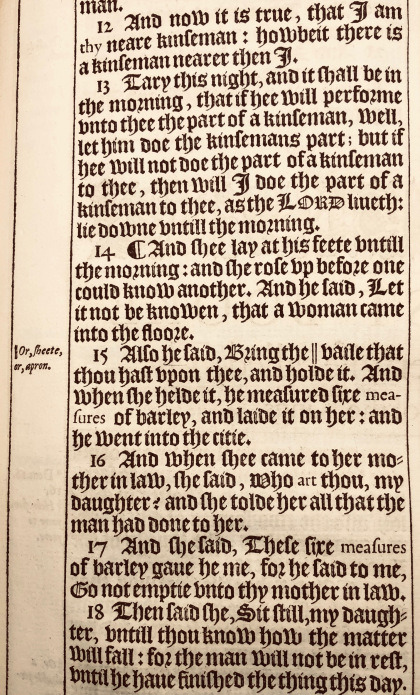

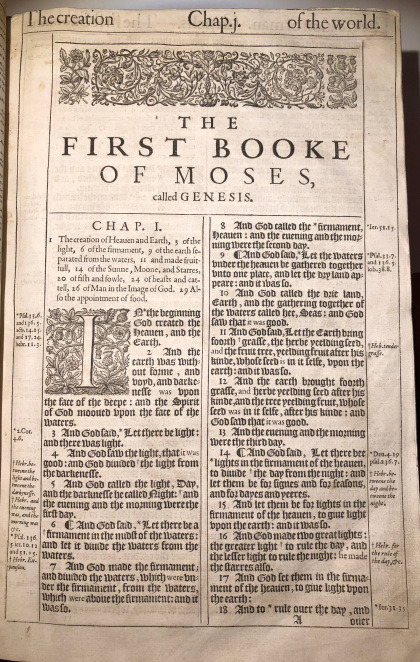


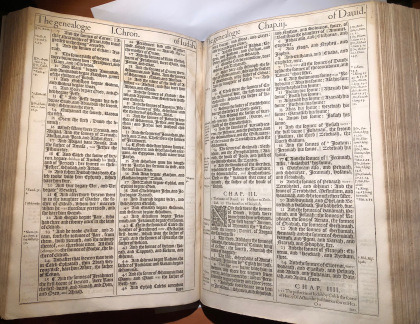
Title Page from 1611 King James Bible

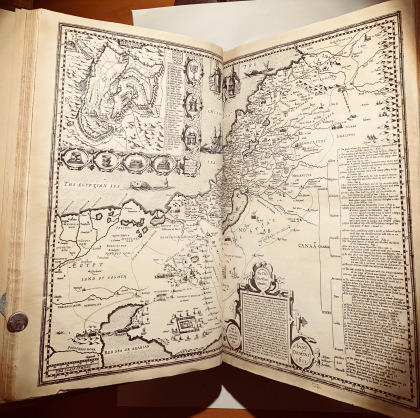


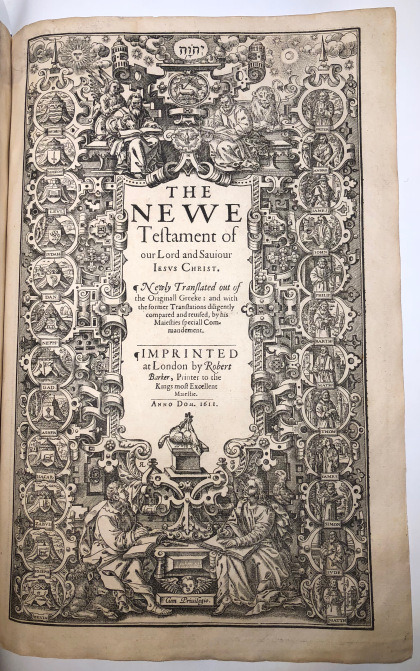
The second pronoun “he” actually refers to Ruth, so it should read “and she went into the citie.” Because of this error, this first edition is often referred to as “The Great He Bible.” (after the Hebrew text), rather than “and she went” (after the Latin Vulgate) in the second edition. Also with all other first edition readings.
210J KJV
The Holy Bible, : conteyning the Old Testament, and the New: newly translated out of the originall tongues: & with the former translations diligently compared and reuised, by His Maiesties speciall com[m]andement. Appointed to be read in churches.
Imprinted at London : By Robert Barker, printer to the Kings most Excellent Maiestie. 1611 $230,000
Large Folio, 15 ¼ x 10 ½ inches : 732 leaves A6 B2 C6 D4 A-5C6; A-2A6}. complete
see below
DEscriptive positioning and condition of the signatures.
A-C⁶D²; (O.T. and Apocrypha) A-Ccccc⁶; (N.T.) A-Aa⁶unpaginated or foliated. The General title mounted and with c. 18 small holes, mostly from old attempts to ink out a prior ownership inscription; the next several leaves have rust-like marks resulting from the damage to the title just mentioned; the double page map is a facsimile. There is a strip is torn from the blank outer margin of X6 (Hebrews 12/3); a small piece is torn from the top of Aa5, removing most of a word of text and a word of the headline, recto & verso; Aa6 (the final leaf) was missing and is replaced in facsimile; the final leaves of the NT are increasingly worn and lack the crisp, clean nature of the bulk of the text. Generally the text is crisp and clean, BUT at both front and rear the top margin is shaved, especially in Exodus & Numbers & to the beginning of Deuteronomy (and again at the end of the NT) touching the rule and occasionally the top of the headlines (elsewhere the top margins are small); there is a dampstain at the top from mid-I Kings, retreating to the inner corner in the Prophets, but persisting there to the Gospels: there is a bit more general staining at the end of the NT; the bottom outer corner is a bit creased and dog-eared pretty much throughout, evidencing the use such a Bible received in its early days as a lectern Bible; the outer edge of the leaves is slightly abraded at a few points.
This copy is bound in full modern calf in an appropriate style, as you can see in the following Images.
Called “the only literary masterpiece ever to have been produced by a committee,”the King James Bible was the work of nearly 50 translators, organized in 6 groups. G.M. “The editors who passed the book through the press were Miles Smith … and Thomas Bilson …”, see Herbert.
Trevelyan stated “for every Englishman who had read Sidney or Spenser, or had seen Shakespeare acted at the Globe, there were hundreds who had read or heard the Bible with close attention as the words of God. The effect of the continual domestic study of the book upon the national character, imagination and intelligence for nearly three centuries to come, was greater than that of any literary movement in our annals, or any religious movement since the coming of St. Augustine.”
Brake-Hellstern Cencus (BHC) of He Bibles 2017 # BHC-119; Carl H. Pforzheimer Library 61; English Short Title Catalogue,; S122347; Pollard, A.W. Short-title catalogue of books printed in England, Scotland, & Ireland and of English books printed abroad, 1475-1640 (2nd ed.),; 2216; Herbert, A.S. Historical catalogue of printed editions of the English Bible, 1525-1961,; 309 Printing and the Mind of Man 114. ;Rumball-Petre, Rare Bibles, 122.
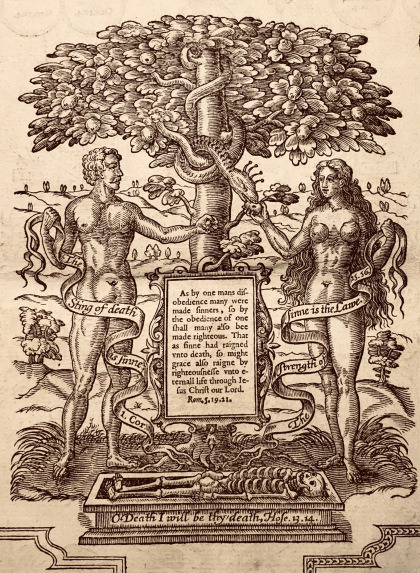
))0((
#4 King James version 1774
The Holy Bible, containing the Old Testament and the New: .
Oxford: printed by T. Wright and W. Gill: and sold by S. Crowder, London; and by W. Jackson, Oxford 1774 $2,000
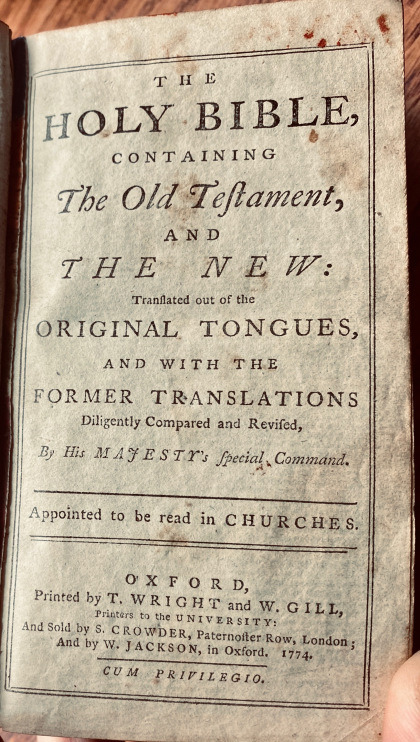
This copy is housed in a a very nice probably original sheep skin covering. The book is neatly bound in full calf that was once read but has faded. The binding is nicely tooled .
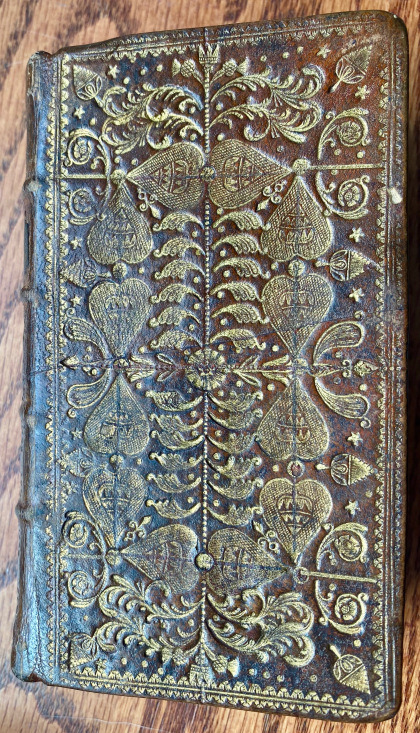
There is an ownership bark on the verso of the fly leaf of J
James McClymont, January 24 1776.

Copies – N.America
American Bible Society LinkJohns Hopkins University, John Work Garrett LinkUniversity of Toronto, Library LinkZion Research Library, Brookline
A few interesting Bibles 1500-1774 I've decided to list them chronologically, Please enjoy. James 1)- 355J Bible Saint Jerome, Biblia cum summariis concordantiis 1500…
#1776#Bibles#Fine Binding#First Catholic English New Testament#First King James Bible#Incunabula#King James Bible#KJV
0 notes
Link
Santa Barbara: Capra Press, 1974. First Edition. Softcover. One of 500 copies in decorated wraps of the first collection of Carver's stories to be published in book form, preceding WILL YOU PLEASE BE QUIET, PLEASE? by two years. SIGNED by the author on the title page. Owner name in ink at the top of the page with the list of titles, owner blindstamp on front endpaper. Somewhat faint dampstain to the bottom of the front cover,
0 notes
Photo


Description: World War I Archive, included assorted documents, poster, certificates, and ephemera, 60 plus items total, pertaining to Judge James A. Newman, whose currency collection is featured in this auction, from the time of his service as First Lieutenant in the U.S. Army, 51st Infantry Regiment, 6th Infantry Division. 1st item: Letter in French with envelope from Mr. and Mme. Terriot of Recey-sur-Ource, Cote-d'Or, dated May 26, 1919, addressed to Monsieur James A. Newman/ 1st Lieutenant 51st Inf./American E. F. France/A. P. O. 777., with translation on Salvation Army stationary, presumably by Newman. The letter states how "greatly we regret not having you with us any longer...There are not many Americans in Recey by now. The company stationed close to us has left yesterday, and others follow it daily. May you all leave with the conviction that the French will always remember their friends (Americans) well and that they will never forget the eternal gratitude the French owe them". They request for Newman to "Please write us often. Your letters will be welcomed, for we will never forget you. Your absence is very noticeable in our house. Trusting that you will visit us, we are forwarding you our best sentiment, our excellent thoughts about you; and do deem us your devoted friends. A Terriot". 1 1/2" dried flower attached to letter, top left corner of first page. 2nd item: Letter in English with envelope from Malnouiy of Recey-sur-Ource, Cote-d'Or, dated December 6, 1946, addressed to M. James A. Newman/Attorney at Law/1210-11 Independent Building/Nashville/Tennessee/U.S.A. The letter begins "I write to say that Mr. Terriot is dead the last week, after a few days of illness. Worn by work, he went to bed for no use again; he kept his lucidity until he expire[d]. My mother remained near him to the last minute, since we were his best friends". Malnouiy writes that "In the France, for the time, we are in a critical situation. The revictualling is very bad and our directing - men think more politics; It's a pity after all things that we had seen during the Germans occupation! Perhaps a day, we will have a veritable chief who thinks French". 3rd item: Pre-World War I chromolithograph poster titled "Men Wanted For the Army" after a painting by Michael P. Whelan (American, 20th Century), published by American Lithography Company, New York, 1909. U.S. Army recruiting poster depicting an officer standing with a soldier, seated on a horse, blowing a bugle. "Apply at ---- Recruiting Station." lower center under image. Signed in the plate, lower right. Housed in a light blue painted wooden frame. Sight - 39 5/8" H x 28 1/2" W. Framed - 41 1/8" H x 30" W. 4th item: Thirty-one (31) page document titled "Selection and organization of Snipers", undated. The first paragraph reads "A good sniper must be a good shot. He must be more inteeligent [sic] than the average man to be used as an observer. As such he must remember what he has observed, and know how to report it. He mus[t] be a man with plenty of guts. Must posses patience. He does not get frequent shots, and must often wait considerable time. He must not fire unless he is pretty certain that he will scorea [sic] hit. He must be physically fit, much more so than the average soldier". Mathematical notations, back cover page. Pages bound by twine, top left and right. 5th-9th items: Six (6) copies, three (3) incomplete, thirteen (13) pages total, of "The Voyage", "a semi-Occasional news periodical published by the Fifty-First United States Infantry in the interest of Sport, Fun and Good-Fellowship, on the occasion of its trip across the Atlantic and on its mission to help make the world safe for Democrats". 10th item: One (1) page document detailing "Platoon Attack Formation" organized under "1st Attack Formation" and "2nd Attack Formation". 11th item: Three (3) page document containing an "Alphabetical List of Officers in Fifty-First Infantry" dated June 3, 1918. Pages stapled, top left corner. 12th item: One (1) U. S. S. Leviathan Abandon Ship card, dated June 5, 1919, for Capt. J. A. Newman, stating that "You are assigned to Life Boat No. 61 located C deck near main mast for the current trip. A. Stanton/Commander, U. S. Navy,/Executive Officer". 13th item: One (1) Sixth Division, U.S. Army Time Inspection Service certificate, No. 17031, dated June 10, 1918, stating "This is to certify that watch No 1082803 make Ham...has been inspected and is up to the standard required in this Division". signed by Griffith-Weaver, Inspector. 14th item: Twelve (12) page official copy of "Memorandums -- Hq. 51st. Inf. & Ft. Oglethorpe, Ga. Now in Force./Memo, Hq. Ft. Oglethorpe, GA. #1." dated June 30, 1917. Facsimile signature of S. F. Howard, cover page. Pages stapled, top left and right corners. 15th item: Two (2) page "Office of Supply Officer, Fifty First Infantry./Camp Forrest, Ga., 12th June, 1918./Memorandum:" from H. Robert W. Herwig, Captain & S. O., 51st Infantry. Pages stapled, top left corner. 16th item: Blank four (4) page "War Department./Quartermaster Corps./Officer's Pay Voucher.", Form No. 336. Front and back pages folded with two loose interior pages.17th item: One (1) page carbon copy of a letter with two (2) page War Department Circular No. 9, dated November 13, 1917 describing field glasses. The letter is a refusal of Newman's request for field glasses from Howard Elliot, Captain, Sig. R.C. A.S., Disbursing Officer, Chicamauga Park, GA, dated January 11, 1918. Letter and circular bound by paper clip, top center. 18th item: One (1) page document listing "Articles" of "Intrenching Tools" and Organization Equipment" in one column with a second column listing "Allowance" of each item. 19th-24th items: Six (6) pages of documents with envelope detailing Newman's loss of equipment will he was stationed in Recey-sur-Ource, Cote-d'Or with voucher for reimbursement for the sum of $174.66, dated February 4 - April 22, 1919. Three pages pinned, top left corner, two pages pinned, top center, one page, dated March 26, 1919, loose. 25th item: One (1) page carbon copy "Advertisement" reading "Come Join the Circus/Enlist in Headquarters Company/51st Infantry./Extraordinary Opportunities...[for] Men of the Following Trades/And Professions Are Required..." including "Pacifists/Trapeze Performers/Doughnut Hole Cutters/Lion Tamers/Beauty Specialists/Tooth Brush Makers" among other positions. 26th item: One (1) page receipt from the Atlantic Hotel, Boulevard Victor-Hugo, Nice, France. 27th-41st item: Fifteen (15) assorted military pins, medals, service ribbons, including one American Legion pin and one uniform button. 42nd item: One (1) faux black leather three-ring address book with photograph of an unidentified man and woman. Illegible pencil writing on front notebook pages, address section mostly blank. Book - 5 1/2" H x 3 1/2" W x 1/2" D. Photograph - 4 1/2" H x 2 7/8" W. 43rd item: One (1) black and white photo of an unidentified solider. Inscription reads "Not J A Newman", en verso. 11" H x 6 3/4" W. 44th item: One (1) miniature Brodie helmet stamped "American Legion Dept of Tenn Nashville" with laurel wreath and five pointed "US" star. 1 3/4" H x 5" W x 5 1/2" D. 45th item: One (1) blue felt with gold trim and writing reading "Welcome Legionnaire". 4" H x 11" W. 11" H x 6 3/4" W. 46th-49th items: Five (5) small flags, including four (4) United States of America flags and two (2) American Legion flags. Approximately 14" H. 50th item: One (1) card stock "disk", "prepared by Lt. James A. Newman Inf. R. C.". 5 1/8" dia. 51st item: One (1) tobacco advertising tin for the "Three Castles" cigarettes, W. D. and H. O. Wills, Bristol and London. 3 1/4" H x 2 3/4" dia. 52nd-56th item: Four (4) shoulder epaulets in one (1) brown canvas drawstring bag labeled "Newman". Bag - 6" H x 6" W. Epaulets - 5 1/2" L. 57th item: One (1) hardback copy of "No. 1923 - Description and Rules for the Management of the United States Rifle, Caliber .30, Model of 1903" published by the Government Printing Office, Washington, D.C., 1917. 9 1/4" H x 6 1/8" W. 58th-60th items: Three (3) black and white photographs, one taken by Fletcher Harvey Schumacher, a Nashville, Tennessee photographer, depicting a man, identified as Billye Newman, en verso of one photograph. Housed in a card stock folder with" Portrait by Fletcher Harvey Schumacher" embossed lower right corner of front cover. Photographs range in size from 7" H x 5 1/8" W to 15 1/8" H x 11" W. Folder - 15 3/8" H x 11 3/8" W. 61st item: One (1) cotton and lace baby bib. 9" L. Early/mid 20th century. Provenance: the collection of the late James A. Newman (Nashville, TN, 1892-1964). (Additional high-resolution photos as well as information about PMG and third-party grading, the Friedberg Numbering System and James A. Newman are available at www.caseantiques.com.)Condition Report: All tems in overall good condition with toning, tears, dampstaining, etc., to be expected from age. 3rd item: Sheet adhered to auxiliary support. Areas of loss to poster, largest 3 5/8", exposing auxiliary support. Scattered foxing spots, largest 3/8", surface of sheet. Scattered creases, wrinkles, largest 5", surface of sheet. Areas of dampstaining, largest 1 1/2", surface of sheet.
https://www.invaluable.com/auction-lot/-1-c-F074542ADB?utm_source=inv_kwalert&utm_medium=email&utm_campaign=keywordalertlive&utm_term=2
2 notes
·
View notes
Text
Dragged another old Muggle book back with me!
Generally okay condition; minimal foxing, a little bumped, binding is all right but slightly loose, outside overs are a bit worn, only noticeably cocked when looking at the spine to check for that sort of thing, a little dampstain on the bottom but no mildew smell, definitely rubbed and sunned, wood pulp based paper as opposed to cotton--not surprising, as it's from a mass production publisher--edges of the paper are toned several shades darker (most of the paper inside is still a fairly bright write, hence the minimal foxing mention), pretty standard cardboard type cover, lovely ads for some of the publisher's other books on the inside front cover and first page, someone's initials on the first blank page done in cursive so lovely I'm almost envious as my own handwriting is awful, more ads on the back page and inside back cover, covers have been re-taped on on the inside, for some reason someone wrote "85" on the inside back cover, overall 366 pages on "maintenance of health" from 1879.
Whoever owned this had amazing handwriting.
Has a nice, faint, standard old book smell that goes along with the slow deterioration of paper and ink over time.
It’s 20 years older than @directoryandle, who I’m sure will be entirely flattered at that comparison (and if he’s not careful, I’m just going to describe him in antique book condition terms because I can)!
This will be fun to read.
This publisher has an entire series of "handy-books of things worth knowing" and they all appear to be listed inside the covers.
This thing sold for less than a pound when it was published (as did all of the others listed), and I had to drop £33 to pry it out of the hands of an antique shop which sounds like one hell of a price increase but, after adjusting for general inflation, if it were sold new today it'd have been roughly a £16 book so it's not that bad.
0 notes
Photo

Mémoires et observations géographique et critiques sur la situation des pays septentrionaux de l'Asie et l'Amérique (Memoirs and geographical observations and criticisms on the situation of the northern countries of Asia and America) by Samuel Engel, 1765
The first edition of Engel’s important Arctic geography, in a monogrammed presentation binding.
Engel availed himself of the most up-to-date geographic intelligence on the region by explorers and cartographers such as Kirilov, Buache, Delisle, and Gmelin, evaluating each in order to come to a more accurate picture of the Arctic. He stated definitively that California was not an island but rather a peninsula and rejected the fantastical “Sea of the West” asserted by Buache and Delisle. On the other hand, his critiques of Müller’s map of Siberia were unfounded, and his understanding of the rivers of Western North America was described by Wagner as characterized by “remarkable imagination.”
Quarto (250 x 190mm). Title in red and black, engraved vignette on dedication page, 2 engraved folding maps (light dampstain at top margin of first few leaves). Contemporary red crushed morocco with gilt monogram of Bonald, edges gilt.
Christie’s
#samuel engel#books#bibliophilia#bibliophile#antiques#antique books#vintage#vintage books#1700s books#1700s#1760s books#1760s
0 notes
Photo

Baidun Fine Antiquities - Since 1927 - www.Baidun.com
FEATURED ITEM: Biblical BOOK OF DANIEL Medieval Manuscript Folios
This Book of Daniel Medieval Manuscript (as of 22 / February / 2017) is still available for sale from www.Baidun.com:
Reference: MS_BZ_1013 Civilization: Byzantine, Medieval, ca. 1400 C.E. Size: H. 32 cm x W. 22.7 cm Condition: Excellent condition Price: Available upon request Provenance: Baidun Collection DIRECT WEB SITE LINK: http://baidun.com/biblical-book-of-daniel-medieval-manuscript-folios/ SHORT URL: www.goo.gl/xW7udZ
BOOK OF DANIEL, from a folio Bible, in Latin, ILLUMINATED MANUSCRIPT ON VELLUM
The Book of Daniel is one of the most loved and treasured books in the Bible. Not only is Daniel revered as one of the great ancient Hebrew prophets of old, but the Book of Daniel is seen as the key to deciphering the symbolism of the Book of Revelation in the New Testament.
Among ancient manuscripts, a manuscript of the Book of Daniel is considered to be a very special and rare treasure. In this Byzantine manuscript from medieval times, a portion of the Book of Daniel is preserved in ten folios as it was written circa 1400 C.E.
Coming from Italy in the 2nd half of the 14th century CE, this book measures 320 x 227 mm and includes 10 leaves. Each leaf/page has two columns of 48 lines written in black ink in a round gothic bookhand between four verticals and 49 horizontals ruled in plummet. There are rubrics of red, letters of running headings and chapter numbers alternately red and blue, initials of red or blue with cusps and flourishing of both colors extending beyond the height of the text to open each chapter.
TWO ILLUMINATED FOLIATE INITIALS and HISTORIATED INITIAL WITH TEXT-HEIGHT ACANTHUS BORDER in pastel colors and burnished gold (tiny area of dampstaining at top of margin of first three folios).
20th-century half pigskin (slightly rubbed at extremities).
These leaves must once have been part of an extremely handsome and elegantly produced folio Bible. The delicate forms of the acanthus sprays, their twisting leaves turning from pale blue to pink and orange and from yellow to orange, point to an origin in Umbria, probably Perugia, around the middle to third quarter of the 14th century CE.
Serious collectors and connoisseurs of old bibles, old manuscripts, and specifically old bible manuscripts will certainly appreciate the value of medieval illuminated manuscripts such as this one of the Book of Daniel. A rare manuscript treasure such as this one makes an outstanding addition to any fine book collection.
PROVENANCE:
The Reverend Anson Phelps Stokes (1874-1958): bookplate inside front cover. The noted clergyman in New York and New England, who also directed the philanthropy of his family’s foundation, had this manuscript as no 5 in the listing of his books, De Ricci and Wilson, Census, II, p.2276, where its acquisition from Goodspeed in 1935 and the presence of the Book of Job from the same manuscript, then in the Goodhart collection, New York were also noted. The manuscript passed from his son, the Reverend
Anson Phelps Stokes II (1905-1986), Bishop of Massachusetts 1956-70, to the Episcopal Theological School, which in 1974 became part of the Episcopal Divinity School, Cambridge, Mass.
CONTENT:
Book of Daniel ff.1v-10v, preceded by the incomplete prologue to Daniel (Stegmüller 494) and followed by the prologues to Hosea (Stegmüller 500 and 507).
BOOK OF DANIEL, from a folio Bible, in Latin, ILLUMINATED MANUSCRIPT ON VELLUM SHORT URL: www.goo.gl/xW7udZ
Baidun Fine Antiquities Jerusalem www.Baidun.com www.TheBaidunShop.com www.BaidunFineAntiquities.com
FOLLOW US ON FACEBOOK: https://www.facebook.com/BaidunFineAntiquities/
FOLLOW US ON INSTAGRAM: https://www.instagram.com/baidunfineantiquities/
FOLLOW US ON FLICKR: https://www.flickr.com/people/148463208@N08/
FOLLOW US ON WORDPRESS: https://baidun.wordpress.com
FOLLOW US ON TWITTER: https://twitter.com/baidunfineantiq
FOLLOW US ON TUMBLR: http://baidunfineantiquities.tumblr.com/
FOLLOW US ON GOOGLE+ PLUS: https://plus.google.com/106715984037897740713
FOLLOW US ON LINKED IN: https://il.linkedin.com/in/baidun-fine-antiquities-7aa4b5130
FOLLOW US ON ABOUT.ME: https://about.me/baidunfineantiquities
FOLLOW US ON MEDIUM: https://medium.com/@baidunfineantiquities
0 notes
Photo

Sulphate salts affecting this attic wall contaminated from spot inside the stack, a lot blame flashing but there can be a number of reasons. We can solve it 01226287181 #sulphate #salts #chimneybreast #dampstains #damppatches #wetwalls #barnsley #sheffieldissuper #atsocialmediauk #rotherham #barnsleyfc #wakefield #doncaster #dampsam #alldrydampproofing (at Barnsley) https://www.instagram.com/p/BqkUQc6lmJw/?utm_source=ig_tumblr_share&igshid=19crk1ynajqt3
#sulphate#salts#chimneybreast#dampstains#damppatches#wetwalls#barnsley#sheffieldissuper#atsocialmediauk#rotherham#barnsleyfc#wakefield#doncaster#dampsam#alldrydampproofing
0 notes
Photo

CAZABON, Michel Jean (1813-1888) and CICÉRI, Eugène (1813-1890). Views of Trinidad. Paris: Lemercier, 1851.
CAZABON, Michel Jean (1813-1888) and CICÉRI, Eugène (1813-1890). Views of Trinidad. Paris: Lemercier, 1851. The first edition of “possibly the finest set of engravings that has ever been produced of the West Indes” (Maclean). Born in Trinidad, Cazabon studied in Europe before setting up his studio in Port of Spain in 1848. “Quick to see the need for pictures of Trinidad to illustrate its landscape and architecture to the families and friends of English and French settlers, [Cazabon] ... decided to publish a folio of lithographs and invited subscriptions.” The present album was published in 1851, with lithographs by Eugène Cicéri after Cazabon’s drawings. 149 copies were subscribed. Abbey Travel II, 696; MacLean, Cazabon: an Illustrated Biography, 1986. Oblong folio (287 x 402mm). Lithographic title, 18 tinted lithographs interleaved with tissue guards, list of subscribers (spotting, occasionally affecting plates; faint dampstain to final leaves). Contemporary cloth-backed marbled boards (light wear to edges, spine chipped).
2 notes
·
View notes
Photo

Grundig (zine) by Jesse Mills and Michael Ismerio (eds.)
RARE. xxxvi p.; ill. Ex-library (the now-defunct Junto Local 91 Radical Library of Winnipeg) with stamp, stickers, and writing to covers, significant wear, including tears, nicks, etc. and dampstains throughout, which do not impact readability of text... more
Offered By The Mortuary Library
#Jesse Mills and Michael Ismerio (eds.)#Adventure#Grundig (zine)#Biography / Autobiography#Art & Culture#Humour#Zines#Travel#biblio#biblio.com
0 notes
Link
Two slim, tall quarto (9' x 12') volumes bound in imitation vellum reproducing in dark grass-green ink a photograph by Edward Weston who has illustrated the volume with 49 photographs specially commissioned for this book and made into exquisitely clear half-tones printed on coated paper. Each spine has a leather label with the title stamped in gilt. With an introduction by Mark Van Doren. Copy #1047 of 1500 SIGNED by the photographer on the colophon page. A masterpiece of the modern photographically illustrated book. Tasteful bookplate on each front pastedown. Just a touch of wear to the spine tips. About Fine in a Near Fine slipcase with faint dampstaining to the edge of one side. Uncommon in this condition
0 notes
Link
First Edition Original green cloth with gilt lettering on the cover and a heavily gilt-decorated spine, uncut, top edge gilt. Portrait frontispiece of an elderly Whitman. BAL 21447: without corrections made in later printings, Sequence 2, Binding D. Most of the text reprints previous material except for the 13 poems in 'Old Age Echoes,' which are printed here for the first time. A special copy in that the publishers have INSCRIBED it on the front endpaper to Walt Whitman's niece: 'Miss Jessie L. Whitman/With the Compliments/of the Publishers.' Paper split at front gutter, old dampstain at bottom gutter affecting the last half of the text; just a touch of wear to the spine tips. Overall Near Fine
0 notes